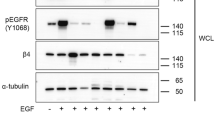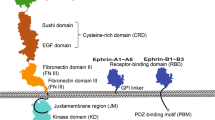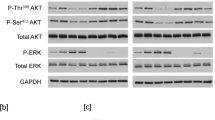Abstract
The Neuregulins and their receptors, the ErbB/HER subfamily of receptor tyrosine kinases, have critical roles in animal physiology, and their deregulation is frequent in cancer. Here we report the identification of the guanine nucleotide exchange factor, phosphatidylinositol 3,4,5-triphosphate-dependent Rac exchanger 1 (P-Rex1), as a novel mediator in signalling by ErbB/HER receptors. P-Rex1 was formerly described as a phosphoinositide 3-kinase and Gβγ activated protein that regulates Rac function. We define how ErbB/HER receptors regulate P-Rex1 function, which involves dephosphorylation of inhibitory residues, and phosphorylation of activating residues of P-Rex. The net balance resulting from activation of this phosphorylation/dephosphorylation cycle of P-Rex1 favours Rac activation. Molecular and biological studies indicated that P-Rex1 phosphorylation regulated the proliferation of breast cancer cells, and P-Rex1 knockdown affected their migration or invasiveness, as well as their in vivo tumourigenic potential. Moreover, as we found correlation between high P-Rex1 expression and poor patient outcome in breast cancer, P-Rex1 targeting may be therapeutically relevant in cancer.
This is a preview of subscription content, access via your institution
Access options
Subscribe to this journal
Receive 50 print issues and online access
$259.00 per year
only $5.18 per issue
Buy this article
- Purchase on Springer Link
- Instant access to full article PDF
Prices may be subject to local taxes which are calculated during checkout






Similar content being viewed by others
References
Adam L, Vadlamudi R, Kondapaka SB, Chernoff J, Mendelsohn J, Kumar R . (1998). Heregulin regulates cytoskeletal reorganization and cell migration through the p21-activated kinase-1 via phosphatidylinositol-3 kinase. J Biol Chem 273: 28238–28246.
Atlas E, Cardillo M, Mehmi I, Zahedkargaran H, Tang C, Lupu R . (2003). Heregulin is sufficient for the promotion of tumorigenicity and metastasis of breast cancer cells in vivo. Mol Cancer Res 1: 165–175.
Barber MA, Donald S, Thelen S, Anderson KE, Thelen M, Welch HC . (2007). Membrane translocation of P-Rex1 is mediated by G protein betagamma subunits and phosphoinositide 3-kinase. J Biol Chem 282: 29967–29976.
Baselga J, Arteaga CL . (2005). Critical update and emerging trends in epidermal growth factor receptor targeting in cancer. J Clin Oncol 23: 2445–2459.
Breuleux M . (2007). Role of heregulin in human cancer. Cell Mol Life Sci 64: 2358–2377.
Cabrera N, Diaz-Rodriguez E, Becker E, Martin-Zanca D, Pandiella A . (1996). TrkA receptor ectodomain cleavage generates a tyrosine-phosphorylated cell-associated fragment. J Cell Biol 132: 427–436.
Carraway III KL, Sliwkowski MX, Akita R, Platko JV, Guy PM, Nuijens A et al. (1994). The erbB3 gene product is a receptor for heregulin. J Biol Chem 269: 14303–14306.
de Alava E, Ocana A, Abad M, Montero JC, Esparis-Ogando A, Rodriguez CA et al. (2007). Neuregulin expression modulates clinical response to trastuzumab in patients with metastatic breast cancer. J Clin Oncol 25: 2656–2663.
Donald S, Hill K, Lecureuil C, Barnouin R, Krugmann S, John Coadwell W et al. (2004). P-Rex2, a new guanine-nucleotide exchange factor for Rac. FEBS Lett 572: 172–176.
Esparis-Ogando A, Diaz-Rodriguez E, Montero JC, Yuste L, Crespo P, Pandiella A . (2002). Erk5 participates in neuregulin signal transduction and is constitutively active in breast cancer cells overexpressing ErbB2. Mol Cell Biol 22: 270–285.
Esteva FJ, Yu D, Hung MC, Hortobagyi GN . (2009). Molecular predictors of response to trastuzumab and lapatinib in breast cancer. Nature Rev Clin Oncol 7: 98–107.
Fine B, Hodakoski C, Koujak S, Su T, Saal LH, Maurer M et al. (2009). Activation of the PI3K pathway in cancer through inhibition of PTEN by exchange factor P-REX2a. Science 325: 1261–1265.
Hill K, Krugmann S, Andrews SR, Coadwell WJ, Finan P, Welch HC et al. (2005). Regulation of P-Rex1 by phosphatidylinositol (3,4,5)-trisphosphate and Gbetagamma subunits. J Biol Chem 280: 4166–4173.
Holmes WE, Sliwkowski MX, Akita RW, Henzel WJ, Lee J, Park JW et al. (1992). Identification of heregulin, a specific activator of p185erbB2. Science 256: 1205–1210.
Hynes NE, Lane HA . (2005). ERBB receptors and cancer: the complexity of targeted inhibitors. Nat Rev Cancer 5: 341–354.
Joseph RE, Norris FA . (2005). Substrate specificity and recognition is conferred by the pleckstrin homology domain of the Dbl family guanine nucleotide exchange factor P-Rex2. J Biol Chem 280: 27508–27512.
Krane IM, Leder P . (1996). NDF/heregulin induces persistence of terminal end buds and adenocarcinomas in the mammary glands of transgenic mice. Oncogene 12: 1781–1788.
Larsen MR, Thingholm TE, Jensen ON, Roepstorff P, Jorgensen TJ . (2005). Highly selective enrichment of phosphorylated peptides from peptide mixtures using titanium dioxide microcolumns. Mol Cell Proteomics 4: 873–886.
Massagué J, Pandiella A . (1993). Membrane-anchored growth factors. Annu Rev Biochem 62: 515–541.
Mayeenuddin LH, Garrison JC . (2006). Phosphorylation of P-Rex1 by the cyclic AMP-dependent protein kinase inhibits the phosphatidylinositiol (3,4,5)-trisphosphate and Gbetagamma-mediated regulation of its activity. J Biol Chem 281: 1921–1928.
Montero JC, Rodriguez-Barrueco R, Ocana A, Diaz-Rodriguez E, Esparis-Ogando A, Pandiella A . (2008). Neuregulins and cancer. Clin Cancer Res 14: 3237–3241.
Montero JC, Rodriguez-Barrueco R, Yuste L, Juanes PP, Borges J, Esparis-Ogando A et al. (2007). The extracellular linker of pro-neuregulin-alpha2c is required for efficient sorting and juxtacrine function. Mol Biol Cell 18: 380–393.
Qin J, Xie Y, Wang B, Hoshino M, Wolff DW, Zhao J et al. (2009). Upregulation of PIP3-dependent Rac exchanger 1 (P-Rex1) promotes prostate cancer metastasis. Oncogene 28: 1853–1863.
Rosenfeldt H, Vazquez-Prado J, Gutkind JS . (2004). P-REX2, a novel PI-3-kinase sensitive Rac exchange factor. FEBS Lett 572: 167–171.
Slamon DJ, Godolphin W, Jones LA, Holt JA, Wong SG, Keith DE et al. (1989). Studies of the HER-2/neu proto-oncogene in human breast and ovarian cancer. Science 244: 707–712.
Sliwkowski MX, Schaefer G, Akita RW, Lofgren JA, Fitzpatrick VD, Nuijens A et al. (1994). Coexpression of erbB2 and erbB3 proteins reconstitutes a high affinity receptor for heregulin. J Biol Chem 269: 14661–14665.
Tsai MS, Shamon-Taylor LA, Mehmi I, Tang CK, Lupu R . (2003). Blockage of heregulin expression inhibits tumorigenicity and metastasis of breast cancer. Oncogene 22: 761–768.
Welch HC, Coadwell WJ, Ellson CD, Ferguson GJ, Andrews SR, Erdjument-Bromage H et al. (2002). P-Rex1, a PtdIns(3,4,5)P3- and Gbetagamma-regulated guanine-nucleotide exchange factor for Rac. Cell 108: 809–821.
Yang C, Klein EA, Assoian RK, Kazanietz MG . (2008). Heregulin beta1 promotes breast cancer cell proliferation through Rac/ERK-dependent induction of cyclin D1 and p21Cip1. Biochem J 410: 167–175.
Yang C, Liu Y, Lemmon MA, Kazanietz MG . (2006). Essential role for Rac in heregulin beta1 mitogenic signaling: a mechanism that involves epidermal growth factor receptor and is independent of ErbB4. Mol Cell Biol 26: 831–842.
Yuste L, Montero JC, Esparis-Ogando A, Pandiella A . (2005). Activation of ErbB2 by overexpression or by transmembrane neuregulin results in differential signaling and sensitivity to herceptin. Cancer Res 65: 6801–6810.
Acknowledgements
This work was supported by grants from the Ministry of Science and Innovation of Spain (BFU2006-01813/BMC and BFU2009-07728/BMC) and by the Consejería de Sanidad de la JCYL. JCM receives support from the Cancer Center Network Program from the ISCIII (RD06/0020/0041), and SS from the Juan de la Cierva Program. Our Cancer Research Institute, and the work carried out at our laboratory receive support from the European Community through the regional development funding program (FEDER), and from the Fundación Ramón Areces. We thank Drs Heidi CE Welch and Mikio Hoshino for providing the myc-tagged P-Rex1 and an anti-P-Rex antibody, respectively.
Author information
Authors and Affiliations
Corresponding author
Ethics declarations
Competing interests
The authors declare no conflict of interest.
Additional information
Supplementary Information accompanies the paper on the Oncogene website
Supplementary information
Rights and permissions
About this article
Cite this article
Montero, J., Seoane, S., Ocaña, A. et al. P-Rex1 participates in Neuregulin-ErbB signal transduction and its expression correlates with patient outcome in breast cancer. Oncogene 30, 1059–1071 (2011). https://doi.org/10.1038/onc.2010.489
Received:
Revised:
Accepted:
Published:
Issue Date:
DOI: https://doi.org/10.1038/onc.2010.489
Keywords
This article is cited by
-
PDCD4 limits prooncogenic neuregulin-ErbB signaling
Cellular and Molecular Life Sciences (2021)
-
PREX1 drives spontaneous bone dissemination of ER+ breast cancer cells
Oncogene (2020)
-
Overexpression of PREX1 in oral squamous cell carcinoma indicates poor prognosis
Journal of Molecular Histology (2020)
-
Identification of P-Rex1 as an anti-inflammatory and anti-fibrogenic target for pulmonary fibrosis
Scientific Reports (2016)
-
Phorbol myristate acetate suppresses breast cancer cell growth via down-regulation of P-Rex1 expression
Protein & Cell (2016)



